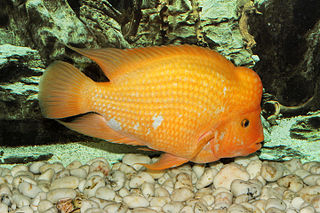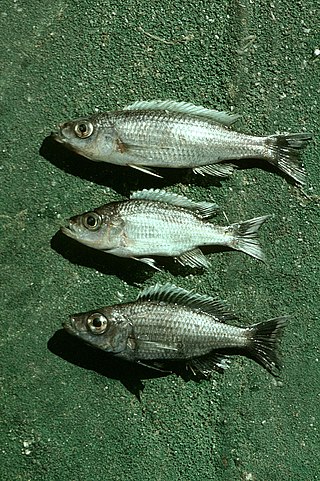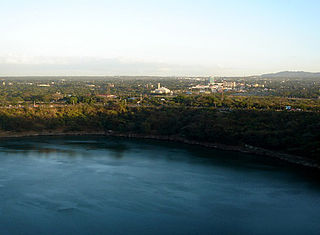
Cichlids are fish from the family Cichlidae in the order Cichliformes. Traditionally Cichlids were classed in a suborder, the Labroidei, along with the wrasses (Labridae), in the order Perciformes, but molecular studies have contradicted this grouping. On the basis of fossil evidence, it first appeared in Argentina during the Early Eocene epoch, about 48.6 million years ago; however, molecular clock estimates have placed the family's origin as far back as 67 million years ago, during the late Cretaceous period. The closest living relative of cichlids is probably the convict blenny, and both families are classified in the 5th edition of Fishes of the World as the two families in the Cichliformes, part of the subseries Ovalentaria. This family is large, diverse, and widely dispersed. At least 1,650 species have been scientifically described, making it one of the largest vertebrate families. New species are discovered annually, and many species remain undescribed. The actual number of species is therefore unknown, with estimates varying between 2,000 and 3,000.

Pseudotropheus is a genus of fishes in the family Cichlidae. These mbuna cichlids are endemic to Lake Malawi in Eastern Africa.

Characeae is a family of freshwater green algae in the order Charales, commonly known as stoneworts. They are also known as brittleworts or skunkweed, from the fragility of their lime-encrusted stems, and from the foul odor these produce when stepped on.

Maylandia or Metriaclima is a genus of haplochromine cichlids endemic to Lake Malawi in East Africa. They belong to the mbuna (rock-dwelling) haplochromines.

Cynotilapia is a genus of haplochromine cichlids. All fishes in these genus form part of the mbuna flock, the rock-dwelling fishes of Lake Malawi, in the rift valley of East Africa. All species are polygamous, maternal, ovophile mouthbrooders and carry their fry in this fashion for about 20–30 days.

Melanochromis is a genus of haplochromine cichlids endemic to Lake Malawi in Eastern Africa. Ecologically, they belong to the rock-dwelling mbuna cichlids of Lake Malawi.

Amphilophus is a genus of cichlid fishes from Central America, ranging from southern Mexico to Panama. The genus currently contains 23 species, including several that are well known from the aquarium trade. However, studies led by Oldřich Říčan in 2008 and 2016 suggested that several species within Amphilophus should be moved to the genus Astatheros. Species proposed to be moved to Astatheros in 2008 were A. alfari, A. altifrons, A. bussingi, A. diquis, A. longimanus, A. macracanthus, A. margaritifer, A. rhytisma, A. robertsoni and A. rostratus. Further genetic studies led Říčan to put A. macracanthus in Astatheros, but to put A. alfari, A. altifrons, A. bussingi, A. diquis, A. longimanus, A. rhytisma, A. robertsoni and A. rostratus within the genus Cribroheros. Říčan's study suggests that the Astatheros species are more closely related to the Jack Dempsey and rainbow cichlid than to the remaining Amphilophus species.

Amphilophus labiatus is a large cichlid fish endemic to Lake Managua and Lake Nicaragua in Central America. It is also known by the common name red devil cichlid, which it shares with another closely related cichlid, A. citrinellus.

Amphilophus citrinellus is a large cichlid fish endemic to the San Juan River and adjacent watersheds in Costa Rica and Nicaragua. In the aquarium trade A. citrinellus is often sold under the trade name of Midas cichlid. A. citrinellus are omnivorous and their diet consists of plant material, molluscs and smaller fish. The species is closely related to, but not to be mistaken for, Amphilophus labiatus, which shares the nickname red devil cichlid.

Diplotaxodon is a small genus of seven formally described, as well as a number of undescribed, deep-water species of cichlid fish endemic to Lake Malawi in east Africa. These fishes represent a remarkable adaptive radiation of offshore and deep-water adapted fish descended from ancestral shallow water forms. They include the dominant zooplankton-feeding fish of the offshore and deep-water regions of the lake, as well as a number of larger species that appear to feed on small pelagic fishes. Adult sizes range from 10 to 30 cm in total length, depending on species.

The fauna of Nicaragua is characterized by a very high level of biodiversity. Much of Nicaragua's wildlife lives in protected areas. There are currently 78 protected areas in Nicaragua, covering more than 22,000 square kilometers (8,500 sq mi), or about 17% of its landmass.

Tourism in Nicaragua has grown considerably recently, and it is now the second largest industry in the nation. Nicaraguan President Daniel Ortega has stated his intention to use tourism to combat poverty throughout the country.

The protected areas of Nicaragua are areas that have natural beauty or significance and are protected by Nicaragua. Nicaragua has 78 protected areas that cover 22,422 km2, about 17.3% of the nations landmass. The National System of Protected Areas (SINAP) is administered by the Ministry of the Environment and Natural Resources (MARENA).
Barton's cichlid is a species of cichlid endemic to freshwater springs in the upper Panuco River basin of San Luis Potosí, Mexico.

Tiscapa Lagoon is a lagoon of volcanic origin that formed over 10,000 years ago. It is located in the capital city of Managua in Nicaragua, and covers an area of 0.13 km2. Tiscapa Lagoon was protected as a natural reserve on October 31, 1991. The reserve is managed by the Ministry of the Environment and Natural Resources (MARENA) and comprises one of the 78 protected areas of Nicaragua.
Amphilophus chancho is a large cichlid fish endemic to Lake Apoyo in Nicaragua.
Amphilophus zaliosus is a species of cichlid that inhabits Lake Apoyo in Nicaragua. It is known in the aquarium trade as the arrow cichlid. It is an elongate species in the Midas cichlid species complex. The arrow cichlid shares its habitat with five other recently discovered species of this complex.

Herichthys pantostictus, the Chairel cichlid or Atezca cichlid, is a species of cichlid native to the Panuco River drainage of Mexico's Atlantic coast where it is mostly found in moderately fast flowing rivers, slightly brackish, murky lakes and lagoons along the coast. A lacustrine form, formerly described as Herichthys molango and endemic to "Laguna Atezca" in the municipality of Molango, has now been extirpated by introduced species. The species reaches a maximum size of 12.6 centimetres (5 in) SL though most do not exceed 5.6 centimetres (2.2 in), and can also be found in the aquarium trade.
The Cichlid Room Companion (CRC) is a membership-based webpage dedicated to the fishes of the Cichlid family (Cichlidae). The site was launched in May 1996 and offers arguably the most comprehensive authoritative catalogue of cichlids on the web, which is illustrated with more than 25,000 photographs of fishes and 2,000 of habitats, as well as over 300 videos of cichlids and their habitats. It also “offers access to ample information about 253 genera and 2371 species”, a discussion forum as well as many articles about taxonomy, natural history, fish-keeping, field accounts, conservation, and other cichlid related topics; mostly written by citizen scientists and people who specialize in cichlids. The species summaries provided in the form of profiles include taxonomic, distribution and habitat, distribution maps, conservation, natural history, captive maintenance, images, videos, collection records, and an extensive bibliography of the species included and have been prepared by world-class specialists. A document establishes the standards followed in the preparation and maintenance of the cichlid catalogue. The site is administered by its creator and editor, Juan Miguel Artigas-Azas, a naturalist, who is also an aquarist and a nature photographer. In 2008, the American Cichlid Association (ACA) awarded Artigas-Azas the Guy Jordan Retrospective Award, which is the maximum honor that association gives to people who have done extensive contribution to the international cichlid hobby.

Mayaheros is a genus of cichlid fish that is native to Mexico and northern Central America. This genus has a disjunct distribution, with the M. urophthalmus group being found in the Atlantic drainages of southeastern Mexico, Belize, eastern Guatemala, northern Honduras and northeastern Nicaragua, while M. beani is the northernmost cichlid in the Pacific drainage, ranging from Jalisco to Sonora in northwestern Mexico. Both inhabit a wide range of habitats such as freshwater rivers, streams, lakes, ponds, pools and marshes, as well as brackish waters like estuaries, lagoons and mangrove, with members of the M. urophthalmus group sometimes even occurring in caves or coastal marine waters. They are medium-sized to large cichlids that are omnivorous, feeding mostly on small animals, but also plants and detritus.

















